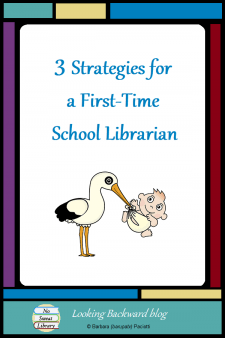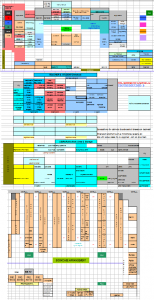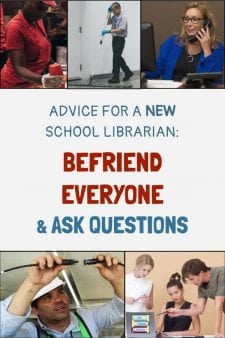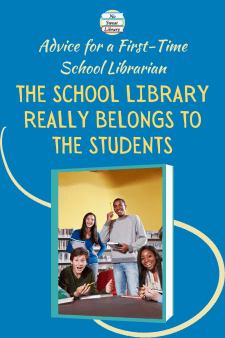 August. I’m a new School Librarian. I’m still a Teacher, but I now have a huge classroom with a mind-boggling array of resources. I need to provide lessons to every student in the school at every grade level but I have no curriculum guide and no class schedule. How do I begin?
August. I’m a new School Librarian. I’m still a Teacher, but I now have a huge classroom with a mind-boggling array of resources. I need to provide lessons to every student in the school at every grade level but I have no curriculum guide and no class schedule. How do I begin?
If you are a new School Librarian, perhaps you feel as overwhelmed as I did when I first walked into my School Library. With my memories as a new librarian, ideas from library courses, and my innate need for organization, I offer 3 strategies for a first-time School Librarian:
- learn everything,
- listen to everyone,
- leave things as they are (for awhile).
LEARN EVERYTHING ABOUT THE LIBRARY
 I’m a “stuff” person. I need to know what I have and where it’s located so I can get it when I need it. Thus, my first task was to learn what was on every shelf and inside every cupboard and drawer in the library. I knew I wouldn’t remember it all, so I used a clipboard of blank paper to draw diagrams. I began in the librarian’s office, moved to the circulation desk, then to the workroom, on to adjoining rooms, and then to the main library space. It took a couple days to compile an extensive set of diagrams about the physical library facility. I took the sheets home and created library maps—labeled & color-coded—on spreadsheets, and I continue to use and modify that same document. It was the smartest “first step” I could have taken as a new School Librarian because I knew:
I’m a “stuff” person. I need to know what I have and where it’s located so I can get it when I need it. Thus, my first task was to learn what was on every shelf and inside every cupboard and drawer in the library. I knew I wouldn’t remember it all, so I used a clipboard of blank paper to draw diagrams. I began in the librarian’s office, moved to the circulation desk, then to the workroom, on to adjoining rooms, and then to the main library space. It took a couple days to compile an extensive set of diagrams about the physical library facility. I took the sheets home and created library maps—labeled & color-coded—on spreadsheets, and I continue to use and modify that same document. It was the smartest “first step” I could have taken as a new School Librarian because I knew:
- what was barcoded and what wasn’t, but needed to be – a task for my TO DO checklist
- purchase orders sent but items not yet received or processed – another task for my TO DO checklist
- resource and technology items likely to be checked out by teachers at the start of school – task for TO DO checklist
- available library supplies for various needs – how the previous librarian managed things & what I need to purchase
- the extent of Fiction, Dewey, and Reference resources in the collection – where to focus my new purchases
- collaborated library lessons given by the previous librarian – who are “library-friendly” teachers & probable lesson requests
- ideas and materials I could use to establish my own teaching and management style – a “Possibilities” checklist
My next step was to explore all the files and applications on the librarian computer workstations to see what the previous librarian had done—which extended my knowledge of her management and lessons—and I rearranged files into folders according to my own organizational style.
As a new faculty member I’d been given a map of the school, so after obtaining permission and a master key from the principal I went through the school—with my trusty clipboard—to identify all the technology and resources that were “library barcoded” in each room. In one unused classroom I found technology items that had been delivered to the school but were still in boxes and hadn’t been processed, along with library items in classrooms that weren’t checked out. During my school “tour” I also identified subordinate technology hubs to the main tech hub in the library workroom. Having such extensive knowledge of every part of the school is a real advantage:
- technicians entering the school are sent to the library so I’m always aware of tech issues or implementations and I can plan new tech lessons for students and colleagues;
- district workers carry my name back to their departments as the “go-to” person at my school;
- I can answer building questions no one else can so I’m invited to be on planning committees;
- before classroom purchases are made, teachers, principal, and secretary check with me to see if we already have the same or similar items, thus saving time and money.
Knowing exactly what I had in the library and the school gave me so much confidence! I’d have an answer for any question or request, and I could maximize my time and money. In short, during my first week I was already becoming an “indispensable” School Librarian!
LISTEN TO EVERYONE & ASK QUESTIONS
 My one suggestion to an incoming new School Librarian is, “Become a trusted colleague of the School Secretary, the Head Custodian, and the Food Services Manager!” These folks are a key source of information about the way the school functions, and if we treat them with the respect they so rightly deserve, they will answer our questions and help us become even better at our job, often doing something for us that they don’t do for anyone else. Just remember to return the favors!
My one suggestion to an incoming new School Librarian is, “Become a trusted colleague of the School Secretary, the Head Custodian, and the Food Services Manager!” These folks are a key source of information about the way the school functions, and if we treat them with the respect they so rightly deserve, they will answer our questions and help us become even better at our job, often doing something for us that they don’t do for anyone else. Just remember to return the favors!
As the school year progresses, welcome district personnel and visitors into the library and, if possible, give them respectful and undivided attention, asking as many questions about their situation as possible. A good impression carries throughout a community and suddenly one day, someone you’ve never met greets you, knows who you are, and wants to help you accomplish something to benefit your students!
Our main purpose as a School Librarian is to support classroom instruction, so we must communicate and collaborate with teachers. On the first PD day in the library at the start of school, I was introduced as the new School Librarian, and I asked my colleagues 2 questions:
- Is the School Library meeting your needs for classroom instruction?
- What can I do as a School Librarian to help you with classroom instruction?
I’d placed brightly-colored 3×5 index cards on the tables to have colleagues write down one suggestion for the School Library and one suggestion for the School Librarian. By the end of that day I knew what had been working, what hadn’t been working, and some new directions to take the School Library, all of which I added to my “Possibilities” checklist. That initial appeal for cooperation led many teachers to seek my input on library visits and lessons throughout the rest of the school year, and my continued willingness to ask questions and listen to suggestions helped build a solid reputation as a valuable collaborative partner!
LEAVE THE LIBRARY AS IT IS (FOR NOW)
Underneath the anxiety, a new School Librarian feels adventurous, itching to implement exciting ideas from library courses! I had my “Possibilities” checklist, but I was wise enough to decide, Don’t Change Anything Yet:
- A physical arrangement may not make sense until a large group is moving around.
- Seemingly frivolous policies and procedures may actually facilitate best use of the library.
- Environment or activities may be crucial to lessons or established teacher and student expectations.
- Real needs can’t be anticipated in a vacuum—the library must be “in use” to know what works and what doesn’t.
 A School Library really belongs to the students and we need to experience the “school culture” of students, to discover their attitudes and needs for their school library. I arranged library visits with ELA teachers for the second week of school and interacted with students as much as possible. By the end of that week I could see how the facility functions for individual students and for classes & teachers, as well as how I functioned within it.
A School Library really belongs to the students and we need to experience the “school culture” of students, to discover their attitudes and needs for their school library. I arranged library visits with ELA teachers for the second week of school and interacted with students as much as possible. By the end of that week I could see how the facility functions for individual students and for classes & teachers, as well as how I functioned within it.
I had to modify my “Possibilities” checklist many times as I worked with teachers and students during scheduled and informal library visits. As I developed a clearer picture of needs, I could slowly begin making changes to improve library use, such as swapping the location of Fiction and Reference and creating new descriptive signage. In January I persuaded ELA teachers to visit the library for a ‘review’ library orientation and everyone loved the changes I’d made.
LEARN THE LIBRARY COLLECTION
In my district we were expected to spend 1/2 our library book budget by the middle of December. Since I was a newbie librarian, I was able to obtain permission to wait until January to purchase books, and I’m so glad I did. Here is what I did—and what you can do—during the 1st semester to maximize the value of book purchases for students, teachers, and classrooms:
- Shelve returned books every day to become intimately familiar with the library collection.
- Run circulation reports every month to see what’s popular with each grade level.
- Note how the location of books affects students browsing and choosing.
- Run collection comparison reports with other same-grade-level schools to learn what’s popular in the community.
- Throughout the semester generate “To Purchase” lists for Fiction, Dewey, Biography, and teacher materials.
My POs were finally sent out, and a couple months later, two pallets stacked high with boxes of books appeared outside the library doors. Our entire school was buzzing with excitement to come visit the library, and as fast as I unpacked boxes, students checked out the new books! My circulation statistics soared and I could always put a great book into a student’s hands.
WHAT I KNOW NOW …
I’ve had jobs in and outside education during my adulthood, and I’ve met many new employees who think they’ve been hired to revolutionize the industry; they come in like gangbusters, trying to change everything without really putting in the time to learn anything. I thank my Dad for his never-forgotten advice: Begin every new position by asking questions, listening to others, and learning as much as possible before offering any suggestions for change. That attitude helped me become a valued employee at every job I’ve had, including being a School Librarian. If I could have a do-over, I wouldn’t do anything differently.
If you enjoyed this blog post, you may also like my follow up: 3 (more) Strategies for a New School Librarian
![]()


